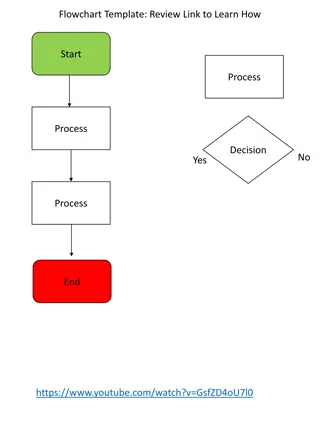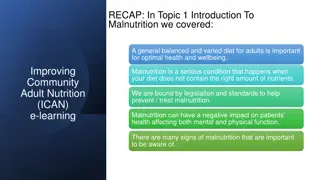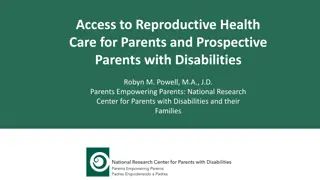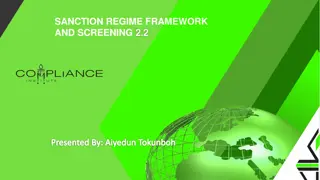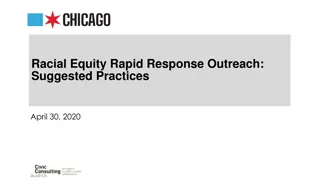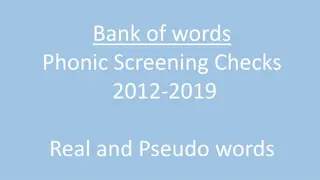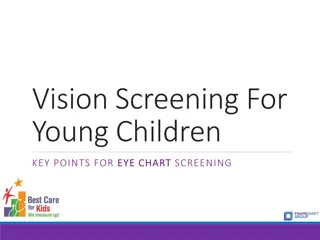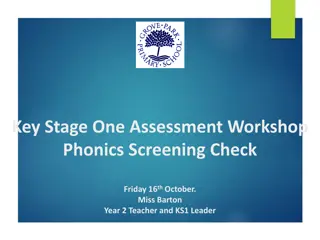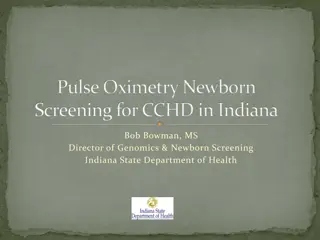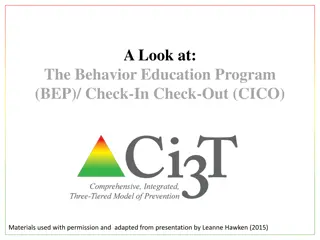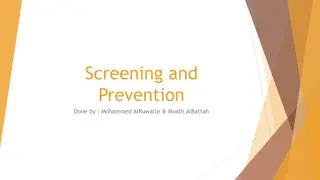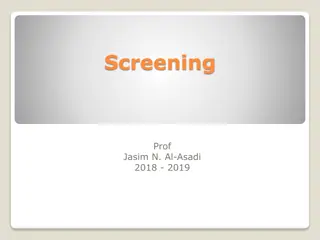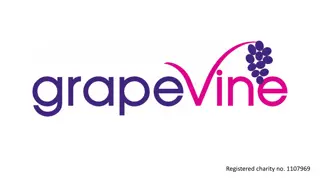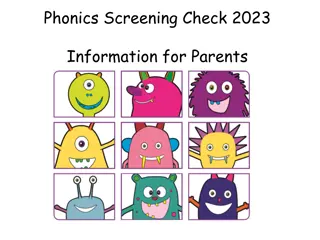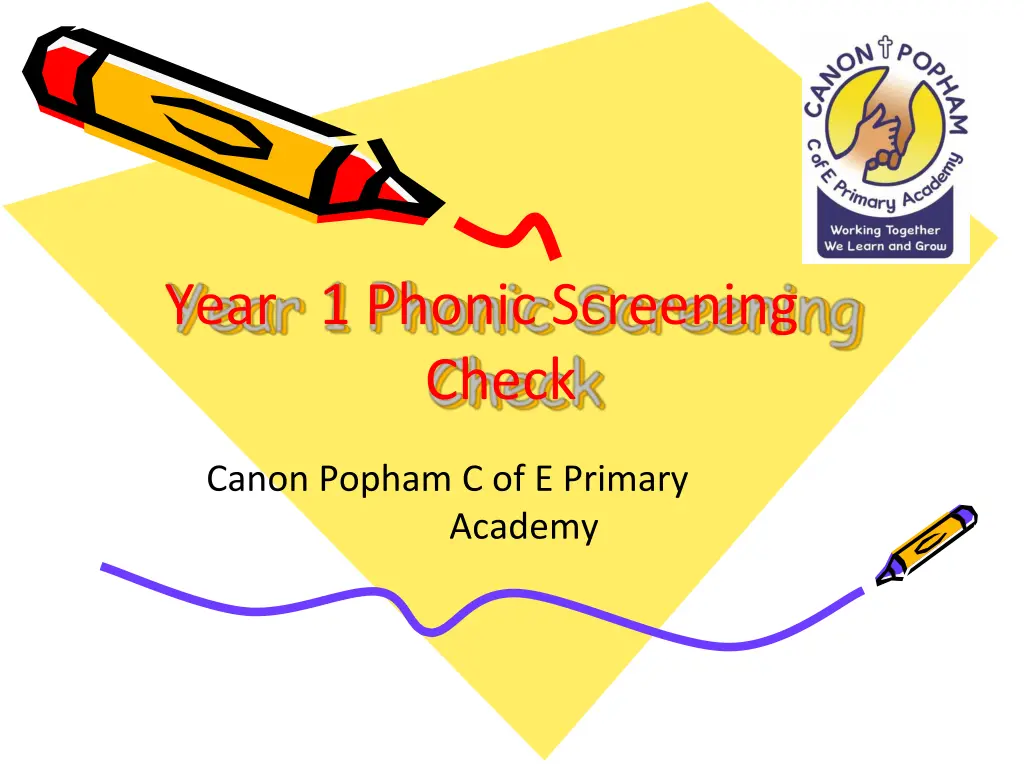
Phonic Screening Check at Canon Popham C of E Primary Academy
Discover key facts about the Year 1 Phonic Screening Check at Canon Popham C of E Primary Academy, a statutory assessment to confirm students' phonic decoding ability. Learn about the structure, organization, and purpose of the screening check, including the use of non-words and different word structures examined. Find out how this assessment helps identify students who may need additional support and how parents will be informed of their child's performance.
Download Presentation

Please find below an Image/Link to download the presentation.
The content on the website is provided AS IS for your information and personal use only. It may not be sold, licensed, or shared on other websites without obtaining consent from the author. If you encounter any issues during the download, it is possible that the publisher has removed the file from their server.
You are allowed to download the files provided on this website for personal or commercial use, subject to the condition that they are used lawfully. All files are the property of their respective owners.
The content on the website is provided AS IS for your information and personal use only. It may not be sold, licensed, or shared on other websites without obtaining consent from the author.
E N D
Presentation Transcript
Year 1 Phonic Screening Check Canon Popham C of E Primary Academy
Key Facts The screening check is a statutory requirement and therefore compulsory for schools to administer. It is a light touch assessment to confirm whether individual pupils have learnt phonic decoding to an appropriate standard and to identify those pupils who require extra support. The screening check will only confirm what we already know about your child s phonic decoding ability. The check will be administered week commencing between 9th June 2025.
Key Facts The phonics screening check is designed to confirm whether individual children have learnt sufficient phonic decoding and blending skills to an appropriate standard. Schools results will not be published but parents will be informed as to how your child performed. Data will be available for use by schools, local authorities and Ofsted as part of their inspection process.
Organisation of the Phonic Screening Check It will take between 4 and 9 minutes to administer and will be an enjoyable experience. The check is divided into 2 sections with each section containing 20 words. Both real and non or pseudo words are used in the check. It is age appropriate. Children will sit with the teacher administering the check and read on a one-to-one basis. The screening check will be stopped if your child is finding it difficult or experiences any signs of distress.
What are non-words and why are they used? Vam, sib, gleep and snemp are all examples of non- words. They are included because they will be new to pupils so there won t be a bias to those with a good vocabulary knowledge or visual memory of words. Pupils who can read non-words should have the skills to decode almost any unfamiliar word. We have ensured that these words have been introduced to minimise confusion to children through the use of alien characters.
Structure of the Screening Check Section 1 A variety of simple word structures using single letters (a consonant digraphs (ch,ck, ff, Section 2 A variety of more complex word structures (CCVCC chimp, CCCVC z), scrap, CCCVCCC scratch) two syllable words, additional consonant digraphs (wh and ph) some less frequent vowel digraphs including split digraphs (a-e, ai, au, aw, ay, ea, e-e, er, ew, i-e, ie, ir, oa, o-e, ou, ow, oy, ue, u-e, ur) and trigraphs (air, igh) ll, ng, sh, ss, th, zz) and frequent and consistent vowel digraphs (ar, ee, oi, oo, or) 12 non-words 8 real words 8 non-words 12 real words
How can I help my child prepare for the screening check? Continue to hear your child read, supporting them with decoding unfamiliar words and discussing the sounds within the word. Continue toread toyour child to develop their vocabulary and enjoymentin literature. Encourage your child to read the word themselves by prompting them with the phrase Special friends, Fred Talk, Read the word . If your child has sound flashcards, sound books, or phonics sheets in their book bag spend a few minutes each night going through these. Try making real and nonsense words using letter tiles including the sounds they have learnt. For example veep, grabe, twime, painting, seat, shirt. Children enjoy playing with sounds, exploring reading nonsense words, and finding a way of changing sounds to make them into real words.
Successful phonic decoding is only one aspect of becoming an effective reader. Written by H.Britten
What will happen if my child does not meet the expected standard? Do not worry, this is just one aspect of learning to read and is a snapshot of your child s ability to read 40 words not a holistic view of their success as a reader. The school will arrange to discuss with you the support that will be put in place to ensure your child meets the necessary standards. Further informal phonic assessments will take place with the class teacher to check the ongoing progress your child is making toward achieving the standard. If your child has not made the required standard by the end of Year 1 they will continue to receive support and intervention. They will then complete the phonic screening check in June 2026 when in Year 2.
Any Questions? Further information www.phonicsplay.co.uk has a range of phonic games to play. Including Picnic on Pluto with Obb and Bob www.ictgames.co.uk www.topmarks.co.uk www.education.gov.uk search for Year 1 Phonic screening check for further information and examples of what the check will look like. NB this is an example as any teachers will not see the check until week commencing 9th June 2025.

